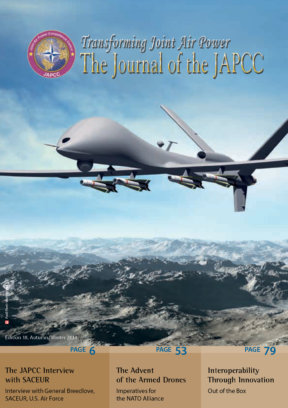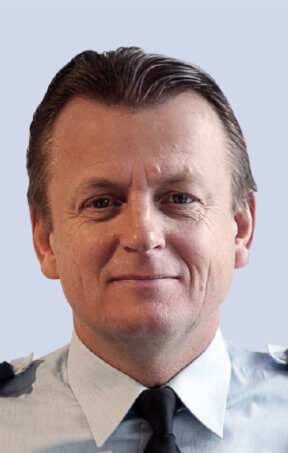History
The Extended Air Defence Task Force (EADTF), comprising Germany, The Netherlands and the United States, was formally established on the 3rd December 1999 in Burbach, Germany. The principal reason for the formation of the EADTF was the frank admission that more robust cooperation was required amongst the NATO PATRIOT weapon system user community. More specific was the requirement for greater levels of interoperability between the nations and in the development of common Training, Tactics and Procedures (TTP’s). The original mission of the EADTF was defined as: “Planning and coordinating combined air defence activities, including training, exercises and interoperability tests. On order, the EADTF will assume mission related command and control functions and / or augment Air Defence/(Theatre) Missile Defence organizations”. In 1999, the EADTF’s manning was just 34 personnel provided by the three countries.
In 2003, U.S. and Dutch personnel from the EADTF took part in Operation DISPLAY DETERRENCE, to complement NATO’s Integrated and Extended Air Defence System in the defence of Turkish territory; Due to internal political reasons, German personnel were not allowed to participate.
In July 2004, due to major restructuring within the German Air Force, the facilities in Burbach were closed and the EADTF was relocated to Heidelberg, adjacent to the Headquarters of the U.S. Army in Europe. However, in 2008, a reorganisation of the U.S. Ground Based Air Defence forces in Europe signalled the withdrawal of the U.S. from the Task Force, resulting in another move to their current location at Ramstein. After finalisation of several efficiency measures, the EADTF’s current staff is comprised of 16 personnel from Germany and The Netherlands with additional observers from France, Poland and the U.S.
The EADTF is neither part of the NATO Command Structure nor the NATO Integrated Air and Missile Defence System (NATINAMDS), however, can support and reinforce existing NATO Headquarters or assume command of / or assist a multi-national Task Force.
The EADTF Today
The EADTF’s current main effort, within the Air and Missile Defence arena, is focussed on Ballistic Missile Defence and Theatre Ballistic Missile Defence operations, notwithstanding the importance of the more-accustomed threats posed by Cruise Missiles (CM), Anti-Radiation Missiles (ARM), Unmanned Aerial Vehicles (UAV) and Aircraft.
Based on current capabilities, the General Officers’ Steering Committee (GOSC), consisting of the Deputy Chiefs of the Air Forces from both nations, is developing the EADTF’s annual program of work, categorised under four major activities:
1. Planning and Execution of BMD Missions
The EADTF can field three planning and execution teams at the same time. Based on political and military guidance, these teams are capable of planning command and control structures, Air & Missile Defence (AMD) sensors and weapon systems. Furthermore, these teams are also capable of executing operations in defence of territory, and its assets, against missile and rocket threats whilst utilising current NATO systems. This is demonstrated by the use of EADTF personnel in support of the deployment of PATRIOT systems to Turkey under the NATO Standing Defence Plan called ACTIVE FENCE.
2. Providing AMD Expertise
The EADTF has gained a level of expertise and knowledge to support NATO (SHAPE and HQ AIRCOM) in developing AMD policy and doctrine, concepts, plans and other AMD-related documentation. The EADTF further supports NATO in the development of new C2 systems (ACCS, PLATO1 and AIRC2IS2). This expertise also enables the EADTF to contribute to the respective national Missile Defence decision-making processes.
3. Education and Training of AMD Personnel
NATO is currently working hard to realise an appropriate education and training capability regarding AMD. Historically, the EADTF has trained NATO, the EU and national personnel on AMD operations and is now supporting NATO’s effort in building up their own organic expertise.
4. Multinational Co-operation
The EADTF has gained experience and expertise in multi-national co-operation through a number of NATO-centric exercises and projects (Nimble Titan, Joint Project Optic Windmill, Joint Project Optic Alliance) and also within the framework of the NATO Russia Council. This level of knowledge has enabled the EADTF to assume leading roles in co-operative efforts.
The EADTF in Future
The proliferation in the ballistic missile threat has become of increasing concern to NATO, and the adoption of (but not necessarily a contribution to) the Air and Missile Defence (AMD) concept by nations, has potentially increased the requirement for the EADTF’s expertise. Whilst the EADTF is well known, it was decided, in December 2012, by the General Officers’ Steering Committee to transform the Task Force into the Air and Missile Defence Competence Centre (CCAMD).
The CCAMD will maintain, if not improve upon the capabilities already established by the EADTF in the fields of operations, concept development, experimentation, intelligence, coordination, and education and training. The CCAMD offers a significant knowledge base for the benefit of participating nations, the NATO Alliance, the EU and other international organisations and scientific institutions e.g. IABG, TNO; this includes the provision of AMD planning & execution support to the NATO Command Structure (NCS). The knowledge and expertise of the CCAMD will contribute significantly toward the emerging European AMD capability, and with a correspondent benefit to the participating nations.
The CCAMD is an Memorandum of Understanding organisation with multi-national control and tasking in response to both NATO’s and national requirements, whether in peacetime or crisis. The current intent is for the CCAMD to provide expertise for AMD projects and program support and to act as a repository of knowledge and a human resource pool of experts for the multiple ‘business’ areas of Air and Missile Defence.












